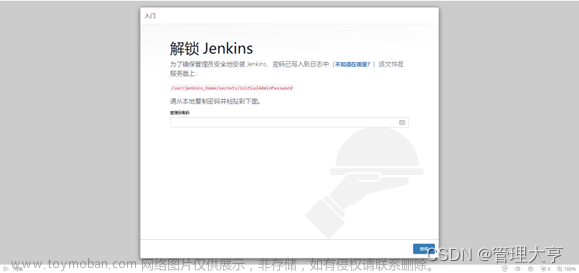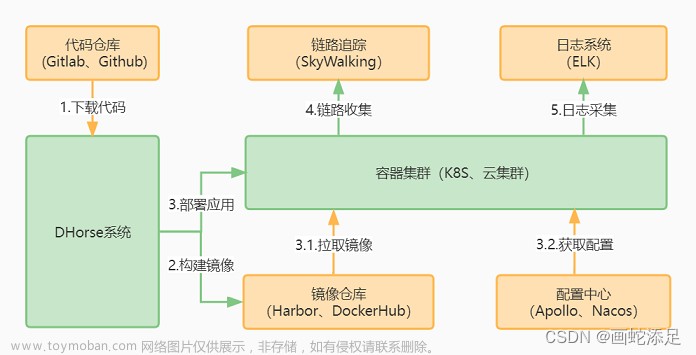综述
首先,本篇文章所介绍的内容,已经有完整的实现,可以参考这里。
在微服务、DevOps和云平台流行的当下,使用一个高效的持续集成工具也是一个非常重要的事情。虽然市面上目前已经存在了比较成熟的自动化构建工具,比如jekines,还有一些商业公司推出的自动化构建工具,但他们都不能够很好的和云环境相结合。那么究竟该如何实现一个简单、快速的基于云环境的自动化构建系统呢?我们首先以一个Springboot应用为例来介绍一下整体的发布流程,然后再来看看具体如何实现。发布的步骤大体如下:
1.首先从代码仓库下载代码,比如Gitlab、GitHub等;
2.接着是进行打包,比如使用Maven、Gradle等;
3.如果要使用k8s作为编排,还需要把步骤2产生的包制作成镜像,比如用Docker等;
4.上传步骤3的镜像到远程仓库,比如Harhor、DockerHub等;
5.最后,下载镜像并编写Deployment文件部署到k8s集群;
如图1所示:
图1
从以上步骤可以看出,发布过程中需要的工具和环境至少包括:代码仓库(Gitlab、GitHub等)、打包环境(Maven、Gradle等)、镜像制作(Docker等)、镜像仓库(Harbor、DockerHub等)、k8s集群等;此外,还包括发布系统自身的数据存储等。
可以看出,整个流程里依赖的环境很多,如果发布系统不能与这些环境解耦,那么要想实现一个安装简单、功能快速的系统没有那么容易。那么有没有合理的解决方案来实现与这些环境的解耦呢?答案是有的,下面就分别介绍。
代码仓库
操作代码仓库,一般系统提供的都有对应Restful API,以GitLab系统提供的Java客户端为例,如下代码:
<dependency>
<groupId>org.gitlab4j</groupId>
<artifactId>gitlab4j-api</artifactId>
<version>4.17.0</version>
</dependency>
比如,我们想获取某个项目的分支列表,如下代码所示:
public List<Branch> branchList(CodeRepo codeRepo, BranchListParam param) {
GitLabApi gitLabApi = gitLabApi(codeRepo);
List<Branch> list = null;
try {
list = gitLabApi.getRepositoryApi().getBranches(param.getProjectIdOrPath(), param.getBranchName());
} catch (GitLabApiException e) {
LogUtils.throwException(logger, e, MessageCodeEnum.PROJECT_BRANCH_PAGE_FAILURE);
} finally {
gitLabApi.close();
}
}
private GitLabApi gitLabApi(CodeRepo codeRepo) {
GitLabApi gitLabApi = new GitLabApi(codeRepo.getUrl(), codeRepo.getAuthToken());
gitLabApi.setRequestTimeout(1000, 5 * 1000);
try {
gitLabApi.getVersion();
}catch(GitLabApiException e) {
//如果token无效,则用账号登录
if(e.getHttpStatus() == 401 && !StringUtils.isBlank(codeRepo.getAuthUser())) {
gitLabApi = new GitLabApi(codeRepo.getUrl(), codeRepo.getAuthUser(), codeRepo.getAuthPassword());
gitLabApi.setRequestTimeout(1000, 5 * 1000);
}
}
return gitLabApi;
}
打包环境
我们以Maven为例进行说明,一般情况下,我们使用Maven打包时,需要首先安装Maven环境,接着引入打包插件,然后使用mvn clean package命令就可以打包了。比如springboot自带插件:
<plugin>
<groupId>org.springframework.boot</groupId>
<artifactId>spring-boot-maven-plugin</artifactId>
<version>2.5.6</version>
<configuration>
<classifier>execute</classifier>
<mainClass>com.test.Application</mainClass>
</configuration>
<executions>
<execution>
<goals>
<goal>repackage</goal>
</goals>
</execution>
</executions>
</plugin>
再比如,通用的打包插件:
<plugin>
<groupId>org.apache.maven.plugins</groupId>
<artifactId>maven-assembly-plugin</artifactId>
<version>3.8.2</version>
<configuration>
<appendAssemblyId>false</appendAssemblyId>
<descriptors>
<descriptor>src/main/resources/assemble.xml</descriptor>
</descriptors>
<outputDirectory>../target</outputDirectory>
</configuration>
<executions>
<execution>
<id>make-assembly</id>
<phase>package</phase>
<goals>
<goal>single</goal>
</goals>
</execution>
</executions>
</plugin>
等等。然后再通过运行mvn clean package命令进行打包。那么,在打包时如果要去除对maven环境的依赖,该如何实现呢?
可以使用嵌入式maven插件maven-embedder来实现。
具体可以这样来做,首先在平台项目里引入依赖,如下:
<dependency>
<groupId>org.apache.maven</groupId>
<artifactId>maven-embedder</artifactId>
<version>3.8.1</version>
</dependency>
<dependency>
<groupId>org.apache.maven</groupId>
<artifactId>maven-compat</artifactId>
<version>3.8.1</version>
</dependency>
<dependency>
<groupId>org.apache.maven.resolver</groupId>
<artifactId>maven-resolver-connector-basic</artifactId>
<version>1.7.1</version>
</dependency>
<dependency>
<groupId>org.apache.maven.resolver</groupId>
<artifactId>maven-resolver-transport-http</artifactId>
<version>1.7.1</version>
</dependency>
运行如下代码,就可以对项目进行打包了:
String[] commands = new String[] { "clean", "package", "-Dmaven.test.skip" };
String pomPath = "D:/hello/pom.xml";
MavenCli cli = new MavenCli();
try {
cli.doMain(commands, pomPath, System.out, System.out);
} catch (Exception e) {
e.printStackTrace();
}
但是,一般情况下,我们通过maven的settings文件还会做一些配置,比如配置工作目录、nexus私服地址、Jdk版本、编码方式等等,如下:
<?xml version="1.0" encoding="UTF-8"?>
<settings xmlns="http://maven.apache.org/SETTINGS/1.0.0"
xmlns:xsi="http://www.w3.org/2001/XMLSchema-instance"
xsi:schemaLocation="http://maven.apache.org/SETTINGS/1.0.0 http://maven.apache.org/xsd/settings-1.0.0.xsd">
<localRepository>C:/m2/repository</localRepository>
<profiles>
<profile>
<id>myNexus</id>
<repositories>
<repository>
<id>nexus</id>
<name>nexus</name>
<url>https://repo.maven.apache.org/maven2</url>
<releases>
<enabled>true</enabled>
</releases>
<snapshots>
<enabled>true</enabled>
</snapshots>
</repository>
</repositories>
<pluginRepositories>
<pluginRepository>
<id>nexus</id>
<name>nexus</name>
<url>https://repo.maven.apache.org/maven2</url>
<releases>
<enabled>true</enabled>
</releases>
<snapshots>
<enabled>true</enabled>
</snapshots>
</pluginRepository>
</pluginRepositories>
</profile>
<profile>
<id>java11</id>
<activation>
<activeByDefault>true</activeByDefault>
<jdk>11</jdk>
</activation>
<properties>
<maven.compiler.source>11</maven.compiler.source>
<maven.compiler.target>11</maven.compiler.target>
<maven.compiler.compilerVersion>11</maven.compiler.compilerVersion>
<project.build.sourceEncoding>UTF-8</project.build.sourceEncoding>
<project.build.outputEncoding>UTF-8</project.build.outputEncoding>
</properties>
</profile>
</profiles>
<activeProfiles>
<activeProfile>myNexus</activeProfile>
</activeProfiles>
</settings>
通过查看MavenCli类发现,doMain(CliRequest cliRequest)方法有比较丰富的参数,CliRequest的代码如下:
package org.apache.maven.cli;
public class CliRequest
{
String[] args;
CommandLine commandLine;
ClassWorld classWorld;
String workingDirectory;
File multiModuleProjectDirectory;
boolean debug;
boolean quiet;
boolean showErrors = true;
Properties userProperties = new Properties();
Properties systemProperties = new Properties();
MavenExecutionRequest request;
CliRequest( String[] args, ClassWorld classWorld )
{
this.args = args;
this.classWorld = classWorld;
this.request = new DefaultMavenExecutionRequest();
}
public String[] getArgs()
{
return args;
}
public CommandLine getCommandLine()
{
return commandLine;
}
public ClassWorld getClassWorld()
{
return classWorld;
}
public String getWorkingDirectory()
{
return workingDirectory;
}
public File getMultiModuleProjectDirectory()
{
return multiModuleProjectDirectory;
}
public boolean isDebug()
{
return debug;
}
public boolean isQuiet()
{
return quiet;
}
public boolean isShowErrors()
{
return showErrors;
}
public Properties getUserProperties()
{
return userProperties;
}
public Properties getSystemProperties()
{
return systemProperties;
}
public MavenExecutionRequest getRequest()
{
return request;
}
public void setUserProperties( Properties properties )
{
this.userProperties.putAll( properties );
}
}
可以看出,这些参数非常丰富,也许可以满足我们的需求,但是CliRequest只有一个默认修饰符的构造方法,也就说只有位于org.apache.maven.cli包下的类才有访问CliRequest构造方法的权限,我们可以在平台项目里新建一个包org.apache.maven.cli,然后再创建一个类(如:DefaultCliRequest)继承自CliRequest,然后实现一个public的构造方法,就可以在任何包里使用该类了,如下代码:
package org.apache.maven.cli;
import org.codehaus.plexus.classworlds.ClassWorld;
public class DefaultCliRequest extends CliRequest{
public DefaultCliRequest(String[] args, ClassWorld classWorld) {
super(args, classWorld);
}
public void setWorkingDirectory(String directory) {
this.workingDirectory = directory;
}
}
定义好参数类型DefaultCliRequest后,我们再来看看打包的代码:
public void doPackage() {
String[] commands = new String[] { "clean", "package", "-Dmaven.test.skip" };
DefaultCliRequest request = new DefaultCliRequest(commands, null);
request.setWorkingDirectory("D:/hello/pom.xml");
Repository repository = new Repository();
repository.setId("nexus");
repository.setName("nexus");
repository.setUrl("https://repo.maven.apache.org/maven2");
RepositoryPolicy policy = new RepositoryPolicy();
policy.setEnabled(true);
policy.setUpdatePolicy("always");
policy.setChecksumPolicy("fail");
repository.setReleases(policy);
repository.setSnapshots(policy);
String javaVesion = "11";
Profile profile = new Profile();
profile.setId("java11");
Activation activation = new Activation();
activation.setActiveByDefault(true);
activation.setJdk(javaVesion);
profile.setActivation(activation);
profile.setRepositories(Arrays.asList(repository));
profile.setPluginRepositories(Arrays.asList(repository));
Properties properties = new Properties();
properties.put("java.home", "D:/java/jdk-11.0.16.2");
properties.put("java.version", javaVesion);
properties.put("maven.compiler.source", javaVesion);
properties.put("maven.compiler.target", javaVesion);
properties.put("maven.compiler.compilerVersion", javaVesion);
properties.put("project.build.sourceEncoding", "UTF-8");
properties.put("project.reporting.outputEncoding", "UTF-8");
profile.setProperties(properties);
MavenExecutionRequest executionRequest = request.getRequest();
executionRequest.setProfiles(Arrays.asList(profile));
MavenCli cli = new MavenCli();
try {
cli.doMain(request);
} catch (Exception e) {
e.printStackTrace();
}
}
如果需要设置其他参数,也可以通过以上参数自行添加。
镜像制作
一般情况下,我们在Docker环境中通过Docker命令来制作镜像,过程如下:
1.首先编写Dockerfile文件;
2.通过docker build制作镜像;
3.通过docker push上传镜像;
可以看出,如果要使用docker制作镜像的话,必须要有docker环境,而且需要编写Dockerfile文件。当然,也可以不用安装docker环境,直接使用doker的远程接口:post/build。但是,在远程服务器中仍然需要安装doker环境和编写Dockerfile。在不依赖Docker环境的情况下,仍然可以制作镜像,下面就介绍一款工具Jib的用法。
Jib是谷歌开源的一套工具,github地址,它是一个无需Docker守护进程——也无需深入掌握Docker最佳实践的情况下,为Java应用程序构建Docker和OCI镜像, 它可以作为Maven和Gradle的插件,也可以作为Java库。
比如,使用jib-maven-plugin插件构建镜像的代码如下:
<plugin>
<groupId>com.google.cloud.tools</groupId>
<artifactId>jib-maven-plugin</artifactId>
<version>3.3.0</version>
<configuration>
<from>
<image>openjdk:13-jdk-alpine</image>
</from>
<to>
<image>gcr.io/dhorse/client</image>
<tags>
<tag>102</tag>
</tags>
<auth>
<!--连接镜像仓库的账号和密码 -->
<username>username</username>
<password>password</password>
</auth>
</to>
<container>
<ports>
<port>8080</port>
</ports>
</container>
</configuration>
<executions>
<execution>
<phase>package</phase>
<goals>
<goal>build</goal>
</goals>
</execution>
</executions>
</plugin>
然后使用命令进行构建:
mvn compile jib:build
可以看出,无需docker环境就可以实现镜像的构建。但是,要想通过平台类型的系统去为每个系统构建镜像,显然通过插件的方式,不太合适,因为需要每个被构建系统引入jib-maven-plugin插件才行,也就是需要改造每一个系统,这样就会带来一定的麻烦。那么有没有不需要改造系统的方式直接进行构建镜像呢?答案是通过Jib-core就可以实现。
首先,在使用Jib-core的项目中引入依赖,maven如下:
<dependency>
<groupId>com.google.cloud.tools</groupId>
<artifactId>jib-core</artifactId>
<version>0.22.0</version>
</dependency>
然后就可以直接使用Jib-core的API来进行制作镜像,如下代码:
try {
JibContainerBuilder jibContainerBuilder = null;
if (StringUtils.isBlank(context.getProject().getBaseImage())) {
jibContainerBuilder = Jib.fromScratch();
} else {
jibContainerBuilder = Jib.from(context.getProject().getBaseImage());
}
//连接镜像仓库5秒超时
System.setProperty("jib.httpTimeout", "5000");
System.setProperty("sendCredentialsOverHttp", "true");
String fileNameWithExtension = targetFiles.get(0).toFile().getName();
List<String> entrypoint = Arrays.asList("java", "-jar", fileNameWithExtension);
RegistryImage registryImage = RegistryImage.named(context.getFullNameOfImage()).addCredential(
context.getGlobalConfigAgg().getImageRepo().getAuthUser(),
context.getGlobalConfigAgg().getImageRepo().getAuthPassword());
jibContainerBuilder.addLayer(targetFiles, "/")
.setEntrypoint(entrypoint)
.addVolume(AbsoluteUnixPath.fromPath(Paths.get("/etc/localtime")))
.containerize(Containerizer.to(registryImage)
.setAllowInsecureRegistries(true)
.addEventHandler(LogEvent.class, logEvent -> logger.info(logEvent.getMessage())));
} catch (Exception e) {
logger.error("Failed to build image", e);
return false;
}
其中,targetFiles是要构建镜像的目标文件,比如springboot打包后的jar文件。
通过Jib-core,可以很轻松的实现镜像构建,而不需要依赖任何其他环境,也不需要被构建系统做任何改造,非常方便。
镜像仓库
类似代码仓库提供的Restful API,也可以通过Restful API来操作镜像仓库,以Harbor创建一个项目为例,代码如下:
public void createProject(ImageRepo imageRepo) {
String uri = "api/v2.0/projects";
if(!imageRepo.getUrl().endsWith("/")) {
uri = "/" + uri;
}
HttpPost httpPost = new HttpPost(imageRepo.getUrl() + uri);
RequestConfig requestConfig = RequestConfig.custom()
.setConnectionRequestTimeout(5000)
.setConnectTimeout(5000)
.setSocketTimeout(5000)
.build();
httpPost.setConfig(requestConfig);
httpPost.setHeader("Content-Type", "application/json;charset=UTF-8");
httpPost.setHeader("Authorization", "Basic "+ Base64.getUrlEncoder().encodeToString((imageRepo.getAuthUser() + ":" + imageRepo.getAuthPassword()).getBytes()));
ObjectNode objectNode = JsonUtils.getObjectMapper().createObjectNode();
objectNode.put("project_name", "dhorse");
//1:公有类型
objectNode.put("public", 1);
httpPost.setEntity(new StringEntity(objectNode.toString(),"UTF-8"));
try (CloseableHttpResponse response = createHttpClient(imageRepo.getUrl()).execute(httpPost)){
if (response.getStatusLine().getStatusCode() != 201
&& response.getStatusLine().getStatusCode() != 409) {
LogUtils.throwException(logger, response.getStatusLine().getReasonPhrase(),
MessageCodeEnum.IMAGE_REPO_PROJECT_FAILURE);
}
} catch (IOException e) {
LogUtils.throwException(logger, e, MessageCodeEnum.IMAGE_REPO_PROJECT_FAILURE);
}
}
k8s集群
同样,k8s也提供了Restful API。同时,官方也提供了各种语言的客户端,下面以Java语言的客户端为例,来创建一个deployment。
首先,引入Maven依赖:
<dependency>
<groupId>io.kubernetes</groupId>
<artifactId>client-java</artifactId>
<version>13.0.0</version>
</dependency>
然后,使用如下代码:
public boolean createDeployment(DeployContext context) {
V1Deployment deployment = new V1Deployment();
deployment.apiVersion("apps/v1");
deployment.setKind("Deployment");
deployment.setMetadata(deploymentMetaData(context.getDeploymentAppName()));
deployment.setSpec(deploymentSpec(context));
ApiClient apiClient = this.apiClient(context.getCluster().getClusterUrl(),
context.getCluster().getAuthToken(), 1000, 1000);
AppsV1Api api = new AppsV1Api(apiClient);
CoreV1Api coreApi = new CoreV1Api(apiClient);
String namespace = context.getProjectEnv().getNamespaceName();
String labelSelector = K8sUtils.getDeploymentLabelSelector(context.getDeploymentAppName());
try {
V1DeploymentList oldDeployment = api.listNamespacedDeployment(namespace, null, null, null, null,
labelSelector, null, null, null, null, null);
if (CollectionUtils.isEmpty(oldDeployment.getItems())) {
deployment = api.createNamespacedDeployment(namespace, deployment, null, null, null);
} else {
deployment = api.replaceNamespacedDeployment(context.getDeploymentAppName(), namespace, deployment, null, null,
null);
}
} catch (ApiException e) {
if (!StringUtils.isBlank(e.getMessage())) {
logger.error("Failed to create k8s deployment, message: {}", e.getMessage());
} else {
logger.error("Failed to create k8s deployment, message: {}", e.getResponseBody());
}
return false;
}
return true;
}
private ApiClient apiClient(String basePath, String accessToken, int connectTimeout, int readTimeout) {
ApiClient apiClient = new ClientBuilder().setBasePath(basePath).setVerifyingSsl(false)
.setAuthentication(new AccessTokenAuthentication(accessToken)).build();
apiClient.setConnectTimeout(connectTimeout);
apiClient.setReadTimeout(readTimeout);
return apiClient;
}
至此,关键的技术点已经介绍完了,更多内容,请参考这里文章来源:https://www.toymoban.com/news/detail-405634.html
也可以参考其他文章:
《DHorse系列文章之操作手册》
《DHorse系列文章之镜像制作》
《DHorse系列文章之maven打包》
《DHorse系列文章之Dubbo项目解决方案》文章来源地址https://www.toymoban.com/news/detail-405634.html
到了这里,关于DevOps基于k8s发布系统的实现的文章就介绍完了。如果您还想了解更多内容,请在右上角搜索TOY模板网以前的文章或继续浏览下面的相关文章,希望大家以后多多支持TOY模板网!












